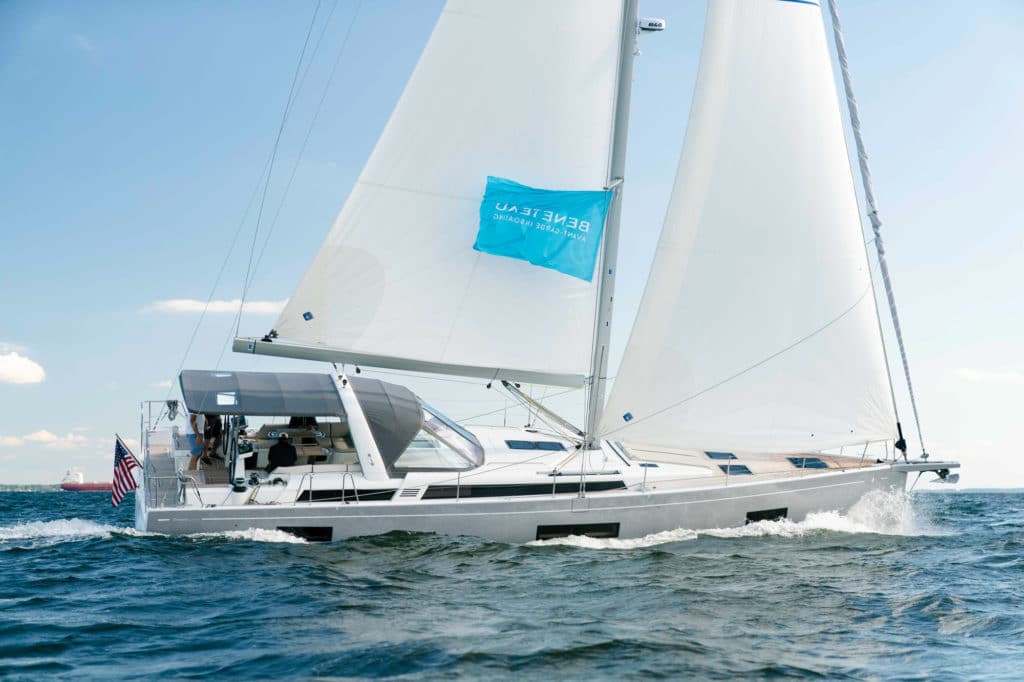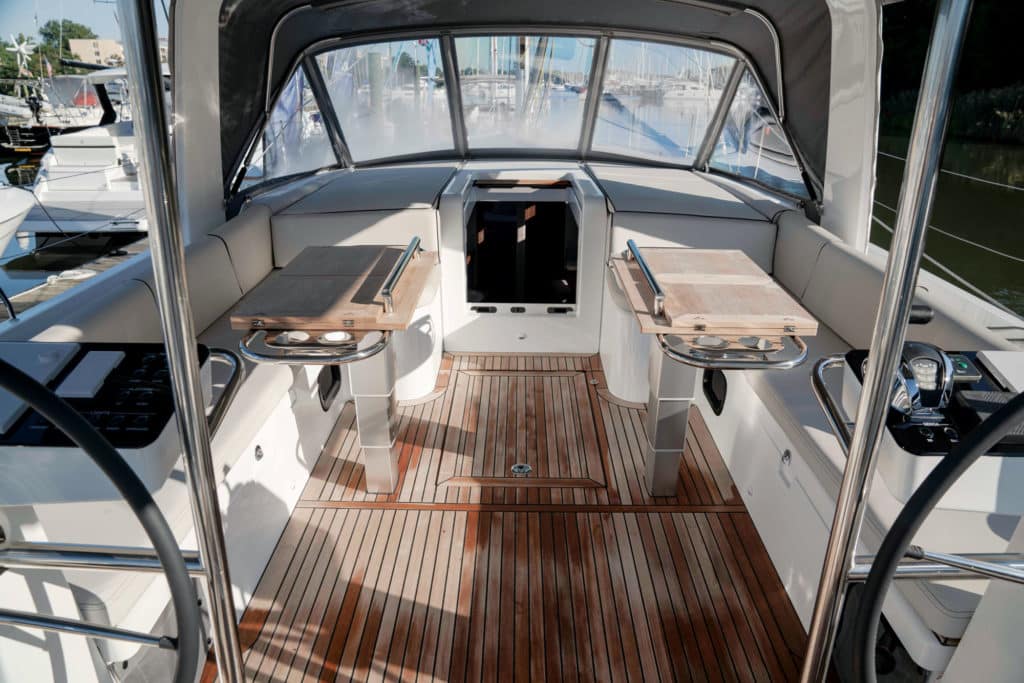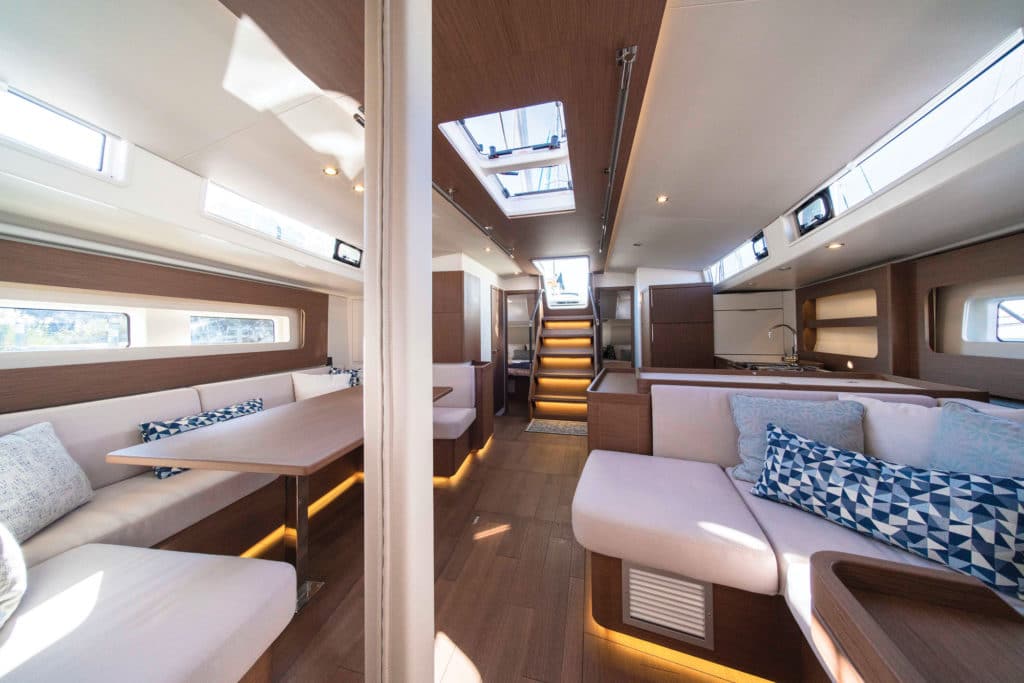
The executives, design team, and craftsmen at the sailing division of Groupe Beneteau have made some interesting, innovative, and even surprising decisions ever since a regime change took place in the marine conglomerate’s upper-management ranks a couple of years back. This was clear from last year’s launching of Beneteau’s First Yacht 53, a sleek and powerful performance cruiser with the contemporary lines evident in the latest offerings from the top European naval architects. Now the company is continuing its ongoing design evolution with its latest dedicated cruising boat, the Oceanis Yacht 54. We tested the boat this past fall on a gorgeous day on Chesapeake Bay with a Beneteau team that couldn’t have been more excited about its potential, and deservedly so. It’s a rangy, clever, impressive yacht.
Over the years, when testing Beneteaus, we’ve become accustomed to reviewing the work of the crème de la crème of the leading practitioners of French naval architecture. So one of the first surprises with this new 54-footer is its design collaboration between a pair of Italians: architect Roberto Biscontini, a veteran of several high-profile America’s Cup campaigns who created the hull, and Lorenzo Argento, the stylist behind many high-end Wally Yachts, who designed the interior layout and accouterments. The Oceanis Yacht 54 actually borrows the basic hull platform from the earlier First Yacht 53, but make no mistake about it: This is a completely new and fresh vessel.
In profile, the Oceanis Yacht 54 is a handsome, purposeful-looking craft. The plumb bow and equally vertical transom maximize the long waterline. A nifty fixed bowsprit is home to the ground tackle and serves as a potential launching pad for reaching sails. There’s a trio of horizontal windows in the hull to port and starboard that look smart and provide natural light and cool ocean views to the interior. The low coach roof slopes forward and transitions to a flush deck forward of the mast. The main feature that links it to the range of Oceanis sisterships is the cockpit arch over the companionway, which anchors the double-ended mainsheet and, on the boat we tested, is the structural centerpiece of a superb Bimini aft and an excellent dodger forward. We’re talking serious shade here.
The cockpit itself is pretty astounding and is a focal point of the design. In 2021, we’re seeing a trend to separate the helm and working sailhandling stations from a dedicated social area free of winches and sheets, aimed purely at comfort. This Oceanis Yacht 54 does this as well or better than anybody. A Beneteau rep referred to this, alternatively, as a “terrace by the sea” and a “rethinking of the center-cockpit” layout. OK, I’ll buy that. There certainly is a lovely, natural, unimpeded flow in the open aisle from the companionway aft, through a passageway between the twin wheels, to the drop-down transom with teak decking that serves as both a boarding/swim platform, and the door opening to a dinghy garage capable of housing an 8-foot-2-inch RIB. The designers clearly feel this big back porch will be the spot where the crew congregates and spends a lot of time, both underway and at anchor, and there’s no question that it’s a very inviting space.

Interestingly, there are no hull chines on the boat, a feature Beneteau introduced with its innovative Sense line that has become ubiquitous on contemporary production cruising boats. The chines were billed as something that would promote stability under sail, but they also expanded interior volume and made for roomier accommodations. Then again, with a 16-foot-5-inch beam, the interior of this yacht is already plenty voluminous.
When it comes to accessing the deck from the cockpit, the Oceanis Yacht 54 has borrowed an idea from its Groupe Beneteau stablemates at Jeanneau, with a slight alteration. Moving forward is a simple matter of stepping outboard from behind the helms and onto an ample side deck, protected by a big bulwark, that gradually rises and transitions into a couple of steps that guide you onto the foredeck. True center-cockpit designs are notorious for the sometimes-difficult gymnastics it requires to step out of them. This is a very elegant solution. Scattered about the teak decks are a quartet of sun pads for spreading out when the hook is down.
There are many, many options to consider on this vessel. For example, take the three different auxiliaries: an 80 hp diesel in a saildrive configuration; a 110 hp engine with a traditional shaft; or Beneteau’s proprietary Dock & Go docking system, a 360-degree rotating pod coupled with a retractable bow thruster that permits the driver to spin the boat in the tightest of spaces. Two rigs are offered: a standard in-mast furling spar measuring just under 79 feet, or a performance stick with a full-batten main and a towering air draft of 85 feet. Likewise, the cast-iron keels, with affixed bulbs, are available in a standard deep version (8 feet, 2 inches) or an optional shoal-draft (6 feet, 7 inches) package.
The boat comes with a full suite of B&G instrumentation, which is as good as it gets, and a standard, proprietary “Ship Control” feature that allows you to monitor and control all the boat’s systems, autopilot, tankage, and so on via a monitor, a tablet, or an app. We’re talking thoroughly modern here. The fiberglass construction is straightforward and employs a balsa core from the deck rail to the keel, as well as an aluminum subfloor that provides structural rigidity to the yacht.

The accommodations and furniture below are clean, contemporary and striking; the Wally influence is clearly very much in play. The standard wood employed is walnut Alpi, which I found hard to beat. There are two floor plans, both of which have a generous saloon and a large owner’s cabin with an en suite head forward and twin, double staterooms aft; a choice of two or three heads are the difference between them (the third head tightens up the galley, to port, opposite the navigation station to starboard). The three-head layout also provides for a tight captain’s quarters in the bow, a space that is otherwise reserved for a giant step-down locker for sails, fenders and such.
We sea-trialed the boat in fairly perfect fall Chesapeake conditions: bright sunshine, blue skies and a sweet, ideal southwesterly of 15 knots or so. And I can state unequivocally that the Oceanis Yacht 54 is simply a blast to sail. The helms are equipped with comfortable seats. All running rigging is led below the deck to winch stations within arm’s length of the wheels that provide ready access to sail trim; this is a boat laid out well for shorthanded maneuvering (the Harken AST system, which stands for “assisted sail trim,” is optional). Upwind, the easily tacked 107 percent genoa further facilitated the easy operation, but the real fun began when we cracked off and unrolled the powerful code zero headsail and cleaved through the small chop effortlessly. The boat was fitted with an impressive suit of excellent sails from French sailmaker Incidence.
With the Oceanis Yacht 54, Beneteau has tacked off on a slightly different but very smooth direction. It’s clearly evident in this distinctive design.
Specifications
Length Overall: 56′2″ (17.2 m)
Waterline Length: 50′6″ (15.4 m)
Beam: 6′5″ (5.0 m)
Draft: 6′7″/8′2″ (1.85/2.49 m)
Sail Area (100%): 1,227 sq. ft. (114 sq. m)
Ballast: 9,918 lb. (4,498 kg)
Displacement: 36,586 lb. (16,595 kg)
Ballast/Displacement: 0.27
Displacement/Length: 127
Sail Area/Displacement: 17.8
Water: 190 gal. (720 L)
Fuel: 106 gal. (250 L)
Mast Height: 78′9″ (24 m)
Engine Specifications: 80 hp Diesel with Saildrive
Designer: Biscontini Yacht Design – Lorenzo Argento (Interior)
Price: $875,000
Sea Trial
Wind Speed: 14 to 15 knots
Sea State: Moderate
Sailing: Closehauled 8.3 knots – Reaching 7.5 knots
Motoring: Cruise (2,300 rpm) 8.4 knots – Fast (2,800 rpm) 8.9 knots
Herb McCormick is CW’s executive editor.








